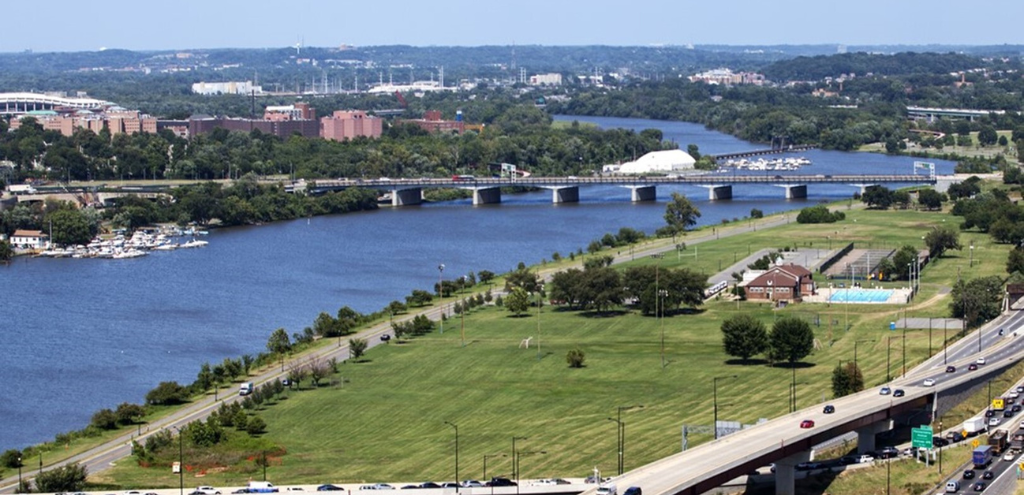THE LEAFLET

Reimagine Anacostia Park
One aspect of our mission at Casey Trees is to protect DC’s tree canopy, but another extension of that mission is to enhance canopy wherever possible. If you participated in our recent advocacy campaign to protect trees at the Rock Creek Park Golf Course, thank you! The collective voice of citizens concerned for our city’s trees is a powerful tool, and we’re hopeful for DC’s trees knowing so many people value our parks and open spaces.
The National Park Service is currently accepting comments on a concept plan for Sections D & E of Anacostia Park, pictured below. The recommendations within the comment period for park refinements are used to inform the final Concept Plan, which will likely be available for review in early to mid-2024. This section of Anacostia Park will be directly adjacent to the 11th Street Bridge Project, ultimately creating a waterfront pedestrian pathway that will unify both sides of the Anacostia River.
Timeline:
Develop Vision and Goals: Spring-Fall 2021
Early Concept Development: Fall 2021-Fall 2022
Concept Refinement: Spring-Fall 2023
Concept Plan Produced: Spring-Fall 2024
Concept Plan Published: Fall 2024
How You Can Help
Reimagining opportunities are a long, iterative process. There will be many more meetings in the future to review project plans as they develop, but this is the first comment period to shape the direction of the full plan. We make sure to ask for a plentiful number of trees in all new developments, but it’s important to ensure new amenities are designed with trees from the beginning – especially with sites as large and accessible as Anacostia Park. This includes providing enough soil for trees to thrive, the appropriate species selection of trees and plants to maximize ecosystem services, and the inclusion of enough trees to begin with – accounting for young tree mortality and the time required for trees to grow into mature giants. When planned well and planted with trees, large parks like this one also go a long way in helping the city reach its 40% canopy goal by 2032.
Some of the key elements in the plan include:
- Waterfront Activation
- Community Fellowship
- Active Recreation
- Access and Connectivity
Trees and Waterfront Activation
When we reimagine the layout of courts, playing fields, and roadways by utilizing trees in landscape design, we can create safer, more unified communities on a pedestrian scale that will be resilient when faced with adverse climate effects like heat and flooding. Restructuring roadways away from the river allows for extended green space and wetland restoration, leading to better pedestrian views and access to the river for fishing, boating and other aquatic activities. Waterfront activation can additionally be enhanced in the park by daylighting Pope Branch Stream and restoring the natural ecosystem along the seawall to manage and mitigate flooding within usable park space.
Trees and Recreation
Trees help to frame and support both passive and active recreation spaces by creating buffers for noise, providing shade and wildlife habitat, and controlling stormwater through low-impact design and selective plantings for species that thrive in wet conditions. Trees and sports fields work well together, as trees can cool basketball and other hard surface courts on hot summer days, and trees offer a natural perimeter to larger field sports like baseball and soccer. Trees and walking trails provide valuable environmental education opportunities, where kids can play and discover new sights, smells, and textures.
Trees and Fellowship/Connectivity
One of the plan’s current visions is to establish a place of belonging, with the goal of fostering a new generation of park and river stewards. Trees are place-makers, where people can create meaningful experiences and step outside of the sun and enjoy a moment of peace. Trees are living museums, to learn about the history of Anacostia Park and the nearby communities, including the native people of Nacotchtank who once lived along the bank of the Anacostia River. Gathering spaces are strengthened through trees, providing more comfortable places to recreate and create meaningful experiences.
Follow this link to review project designs, respond to the 8 topic questions provided and let NPS know how Anacostia Park can be reimagined to better provide access and circulation, active recreation, community fellowship, and waterfront activation. Deadline for comment is December 1.
